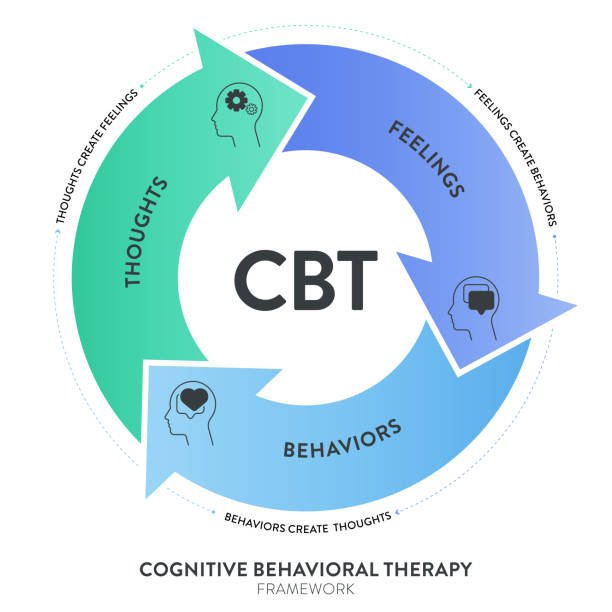
Mental Health Self-improvement Tips – Cognitive Behavioral Therapy (CBT)
Cognitive Behavioral Therapy (CBT) is a short-term psychotherapy model that combines cognitive therapy and behavioral therapy.
The cognitive therapy school of thought believes that an individual’s thinking patterns and belief systems influence their feelings and behaviors. When a person holds incorrect or irrational beliefs, negative emotions and behavioral problems can develop. So the goal of cognitive therapy is to identify and correct these distorted thought patterns.
The school of behavioral therapy believes that individual behavioral responses are generated and maintained to a large extent through learning. Environmental factors and personal past experiences can reinforce certain behaviors and make them habitual. Behavioral therapy increases positive behaviors and decreases negative behaviors by changing reinforcement mechanisms.
Cognitive behavioral therapy combines the concepts of the two. On the one hand, it analyzes whether personal cognitive biases exist and conducts cognitive restructuring; on the other hand, it designs behavioral experiments to test beliefs and learn new coping behaviors. CBT emphasizes the individual’s current thinking and behavior patterns, rather than past experiences, and achieves therapeutic effects through present changes.
CBT is one of the modern mainstream cognitive behavioral psychotherapy models. It is widely used and has been proven to be effective in treating a variety of mental illnesses.
Theoretical foundations of cognitive behavior
The theoretical basis of cognitive behavior mainly comes from the cognitive therapy school and the behavioral therapy school. The founders of the cognitive therapy school include Aaron Beck and Albert Ellis, who believe that individuals develop negative emotions and behaviors because of deviations or errors in their own thinking or belief systems.
For example, patients with obsessive-compulsive disorder may have excessive mysophobia and believe that clutter can cause significant harm. This cognitive distortion can cause anxiety and compulsive cleaning behaviors. The goal of cognitive therapy is to identify these irrational or inappropriate thinking patterns and correct them through argument or evidence, thereby alleviating the individual’s emotional distress.
Major representatives of the behavioral therapy school, such as Joseph Wolpe, believe that individual behavioral responses are generated and maintained to a large extent through learning. Stimuli provided by the environment and an individual’s past experiences can reinforce certain behaviors and make them habitual. Behavioral therapy adjusts an individual’s behavior by changing the reinforcement mechanism to increase positive behaviors and reduce negative behaviors.
CBT combines two major schools of thought and focuses on both the change of individual cognitive patterns and the adjustment of behavioral learning. It analyzes whether an individual’s existing way of thinking and behavior is adaptive, and helps individuals achieve positive changes through cognitive restructuring and behavioral experimental training.

Cognitive behavioral therapy principles
CBT believes that mental illness often occurs because people have learned some wrong thinking patterns and maladaptive coping behaviors in life. For example, patients with post-traumatic stress disorder (PTSD) will have overly sensitive reactions to certain stimuli because they associate certain normal stimuli with past traumatic experiences, forming cognitive biases.
The primary goal of CBT treatment is to identify these distorted cognitions and ineffective coping strategies that contribute to the problem. This requires the therapist to help the patient conduct functional analysis and identify cognitive or behavioral defects based on the patient’s experience and symptoms. Next, the therapist will use various methods, such as argumentation, role playing, behavioral experiments, etc., to help the patient correct wrong thinking and gradually learn new cognitive and coping skills.
CBT emphasizes present thinking and behavior and believes that psychological trauma caused by the past can be healed through changes in the present. It believes that everyone can make positive progress through learning. CBT encourages patients to take an active role in the treatment process and is given homework assignments so that patients can review and apply newly learned skills in their lives.
Cognitive behavioral application scope
- Treat depression
Cognitive behavioral therapy is currently one of the most widely used psychotherapy modalities for the treatment of depression. CBT believes that depression is related to personal negative cognitive patterns and unhealthy behavioral habits.
CBT will first help patients with depression examine their own thinking patterns and discover their own cognitive distortions, such as over-generalization, avoidance of positive information, and personal attribution. This can lead to a mindset in which patients only see the negative side of things. Through example analysis, question guidance, experimental observation, etc., CBT allows patients to realize these distorted thoughts and make corrections, and learn to think about problems from more angles and more rational viewpoints.
At the same time, CBT will also analyze the patient’s behavioral patterns, such as social withdrawal, reduction of activities, abandonment of hobbies, etc. These passive behaviors can trap patients in a vicious cycle. CBT will set behavioral goals and encourage patients to gradually increase positive activities in their schedule, such as exercising, reading, traveling, etc., to gain positive experiences from the behavioral level.
Through cognitive and behavioral adjustments, CBT can help patients with depression stay away from negative emotions and rebuild a healthy life. - Treat Anxiety Disorders
Cognitive behavioral therapy is also one of the main treatments for various anxiety disorders, such as obsessive-compulsive disorder, post-traumatic stress disorder, social anxiety disorder, etc.
CBT will first help patients with anxiety disorders conduct functional analysis to identify external or internal triggers that induce anxiety. Then analyze the cognitive distortions behind anxiety, such as an exaggerated view of risks or an underestimation of abilities. CBT uses methods such as argumentation, experimentation, and mitigation training to help patients rationally view these cognitive errors and adjust negative thinking patterns.
At the behavioral level, CBT uses exposure therapy to allow patients to gradually face the source of anxiety, such as feared objects or social situations, under the guidance of a therapist. This kind of systematic desensitization training can help patients relearn correct coping behaviors and reduce anxiety reactions.
CBT takes into account both cognitive and behavioral adjustments and is a very effective treatment for anxiety disorders. It can provide personalized functional analysis and desensitization programs to help patients control anxiety. - Solve psychological problems
In addition to treating diseases, CBT is also widely used to solve psychological distress and emotional problems in daily life.
For example, in terms of interpersonal relationships, CBT can help individuals gain insight into their own social cognitive biases, such as over-interpreting other people’s reactions and avoiding talking about conflicts. Learn more rational and effective communication skills through role-playing, real-life scenario exercises and other training.
In terms of emotion management, CBT teaches individuals to adjust their cognitions and behaviors to avoid the accumulation and spread of negative emotions. For example, when responding to criticism, rationally analyze the content of the criticism and actively seek improvement measures. CBT can also help people deal with stress. It will guide individuals to analyze stress sources, identify the relationship between external events and their own reactions, and find appropriate adjustment methods, such as relaxation training, pillar therapy, etc.
By enhancing self-awareness, CBT can help individuals optimize maladaptive cognitive and behavioral patterns and gain better adaptability to life. - Dealing with life stress
Cognitive behavioral provides a systematic approach to helping people cope with the various stressors of daily life. CBT begins by asking individuals to self-monitor, recording stressful events, their own cognitive responses, and emotional responses. This can help individuals realize the relationship between external events and their own reactions, and identify thinking patterns that lead to cognitive errors, such as overgeneralization, disaster prediction, etc.
Next, CBT teaches how to view stressors from a more balanced and rational perspective and avoid negative cognitive distortions. For example, take the initiative to find ways to solve stress instead of thinking that the problem has no solution.
In terms of emotional management, CBT trains individuals to use relaxation techniques to reduce negative emotions caused by stress. These techniques include deep breathing, muscle relaxation, visualization, etc.
Through the integrated application of identifying cognitive errors, rational thinking, and relaxation techniques, CBT can improve an individual’s ability to face life’s stress and achieve a stress-reducing effect.

Cognitive behavioral therapy process
- Functional analysis
In the first phase of CBT treatment, the therapist will conduct in-depth interviews with the patient to fully understand the patient’s problem symptoms and possible triggering factors. The therapist will ask the patient about their current main obsessions and symptoms, their frequency and duration, and other information. This can help determine the main symptoms of the problem.
Next, the therapist will ask about the medical history and background related to the problem, such as the circumstances when the symptoms first appeared, influencing factors, etc., to trace the origin of the problem. The therapist will also ask about the patient’s growth environment, interpersonal relationships, work and study status and other life details, and analyze how these external environmental factors affect the problem.
After obtaining all relevant information, the therapist summarizes the cognitive, emotional, and behavioral causes and interactions of the problem. This constitutes the results of functional analysis and provides the basis for subsequent development of detailed treatment plans. - Identify distorted thinking patterns
After completing the initial functional analysis, the next step in CBT treatment is to identify the patient’s cognitive distortions and patterns of thinking errors. Therapists can ask patients to keep a thought diary, detailing their negative thoughts over a period of time and the external triggering events that led to these thoughts.
After analyzing the thought diary, the therapist will point out distorted thinking patterns, such as overgeneralization, misattribution, hostile bias, etc. The therapist can also ask the patient to describe his or her thoughts by giving a hypothetical situation, and then analyze the errors in his or her thinking set.
Therapists can also design some questions to guide patients to self-reflect and discover deviations in their cognitive models. After identifying the distorted thinking patterns, the therapist will make the patient aware of these thinking errors through arguments, providing counter-evidence, etc., and prepare for subsequent cognitive correction. - Change negative thinking and behavior patterns
After cognitive distortions have been identified, the next step in CBT treatment is to help the patient modify these distorted thoughts and adopt more adaptive and positive thinking and behavior patterns. At the cognitive level, the therapist can gradually change the patient’s cognitive biases by providing counter-evidence examples to demonstrate the irrationality of certain distorted thinking.
Therapists can also set up some simulation scenarios to allow patients to imagine coping methods, and provide guidance to train patients to use a more balanced thinking mode. In terms of behavior, the therapist will guide the patient to gradually increase some positive activities, such as doing sports, socializing, learning new skills, etc., to obtain a positive experience.
At the same time, the therapist will also ask the patient to monitor his behavior patterns for a period of time, discover the negative parts of them, and formulate a change plan. Through cognitive and behavioral adjustment training, CBT can help patients develop more adaptive ways of thinking and behaving. - Set goals and train new skills
In the later stages of CBT treatment, the therapist will work with the patient to set some specific treatment goals, which should be operational and measurable. For example, social skills training can set “the number of times you actively talk to others” as a goal.
After setting goals, the therapist uses different training methods to help the patient acquire the cognitive and behavioral skills needed to achieve those goals. For example, in order to train the patient’s social skills, role-playing simulation conversations can be conducted first. The therapist observes and gives feedback to increase the patient’s awareness. Then gradually transition to social training in real scenarios.
If the goal is to cope with stressors, cognitive restructuring exercises such as imaginative reenactment can be performed first to help the patient learn to rationally analyze the source and self-regulate. The patients were then gradually exposed to mild stress stimuli to verify their coping effects. Through this kind of goal-oriented training, patients can develop new thinking patterns and behavioral skills that adapt to life. - Gradually confront sources and apply new skills
In the later stages of CBT treatment, the therapist will use exposure therapy to make the patient face the triggering source of the problem. This is a very important step to verify the effect of the treatment. Specifically, the therapist will first let the patient face some mild triggers with informed consent. For example, patients with social anxiety can first have a conversation with the therapist.
Therapists will guide patients to use new skills they have developed, such as relaxation, rational thinking, etc., to cope with the discomfort. and provide support and feedback. When the patient can handle mild triggers well, the therapist will gradually increase the intensity of the triggers, eventually allowing the patient to face strong triggers in the real environment. During this process, patients gradually develop the ability to use newly acquired skills to deal with problems. This marks a positive outcome for CBT treatment.
Cognitive Behavioral Therapy Forms
- Personal therapy
The most common form of CBT treatment is one-on-one individual counseling. Treatment usually takes place in a private and confidential counseling room. In this environment, therapists can fully assess a patient’s condition and design an individualized treatment plan. The program will set treatment goals based on the patient’s specific problems and select appropriate cognitive and behavioral skills for training. At the cognitive level, therapists will guide patients to identify distorted thinking patterns and learn to correct them through case analysis and alternative thinking. At the behavioral level, therapists will use role-playing, simulation exercises, self-monitoring and other methods to train patients in new coping skills. With support and encouragement, patients can gradually improve their cognition and behavior and learn a more adaptive lifestyle. So personal therapy is suitable for most psychological and emotional problems. - Group therapy
CBT can also be delivered in a group setting, allowing multiple patients to be treated together. Group therapy allows participants to support and encourage each other, reduce treatment stress, and increase motivation. Individuals also gain inspiration when other members share their experiences. In group therapy, therapists can also more easily design simulated social situations so that members can practice social skills with each other. This can train them to deal with anxiety in interpersonal interactions. Therefore, group CBT is ideal for treating social anxiety disorder, interpersonal distress, and more. It combines the benefits of a support system and skills training. Of course, group therapy also has the disadvantage of being less private. So the therapist needs to assess the patient’s suitability and also pay attention to group dynamics to ensure the treatment is effective. - Self-help books
Some self-help books based on CBT can also be used as complementary treatments. Such books use easy-to-understand text and typical cases to teach readers how to identify cognitive distortions or error patterns in their own thinking, such as overgeneralization and labeling. The book also provides specific steps and thinking techniques for correcting these cognitive distortions. For example, analyze the situation from a more objective and rational perspective and avoid overly negative interpretations. Readers can apply the CBT principles and methods in the book in their lives and learn to adjust maladaptive and self-defeating thinking patterns. Of course, self-help books also have limitations, lacking personalized design and direct guidance. Therefore, they are more suitable as supplementary teaching materials to provide support for formal treatment. - Online Course
In recent years, online courses and mobile apps based on CBT theory have also become increasingly popular. These online courses integrate text, audio and video and other content, and use the interactivity of the Internet to guide users to learn the concepts and techniques of CBT. The course will use a large number of life cases to guide users on how to identify distorted thinking and provide exercises for reconstructing thinking. The course will also provide skills training for dealing with anxiety, depression, and stressors, allowing users to gain positive experience. Users can arrange their own learning progress, and the course provides timely feedback. This is an effective extension and complement to CBT treatment. Of course, online courses also have limitations such as poor care and difficulty in evaluating effects. Therefore it is more suitable as an adjunct rather than a replacement for face-to-face therapy.
Cognitive behavioral therapy effects
- Clinical research data
A large number of randomized controlled clinical trials have demonstrated the efficacy of CBT in treating a variety of psychological problems. For anxiety disorders such as generalized anxiety disorder and social anxiety disorder, the group treated with CBT showed significant symptom reduction and improvement in life functioning. The improvement in the control group was smaller. In studies on the treatment of depression, depressive symptoms in the CBT treatment group also decreased significantly compared with the control group, and long-term effects were maintained. An analysis of clinical trial results found that CBT can significantly reduce symptoms of various anxiety disorders and depression. A large body of research evidence supports CBT as one of the safe and effective treatments for common mental illnesses. - For people
CBT is considered effective across a wide range of age groups and for a variety of psychological problems. It can be used not only for anxiety disorders, depression, personality disorders, etc. in adults, but also for behavioral problems, post-traumatic stress disorder, etc. in children and adolescents. However, CBT requires patients to have certain cognitive and understanding abilities to grasp the concepts of CBT and to cooperate with the therapist. CBT may be less suitable for patients with lower cognitive function and those who lack motivation and willingness to cooperate in treatment. Overall, CBT can be widely used by people of all ages who have cognitive and expressive abilities and are willing to cooperate with treatment. But each case requires an assessment of the specific suitability of CBT. - Comparison with other treatment modalities
CBT therapy can reduce a patient’s acute symptoms relatively quickly compared to workarounds and psychoanalytic therapy. CBT focuses more on cultivating patients’ ability to adapt to real life rather than just exploring inner conflicts. But for some cases with deep psychological trauma or inner conflicts, workarounds can be more effective in clarifying and resolving them. In terms of cost-effectiveness, CBT is one of the more preferable treatments. It is structured and short-term, so treatment results can be seen quickly. However, psychotherapy still needs to be tailored to individual conditions, and different methods have their own scope of application. A comprehensive assessment of the individual case is required to determine the most appropriate treatment. - Cognitive behavioral therapy and hypnosis
Cognitive behavioral therapy and hypnosis are two common psychotherapeutic methods used to treat different mental health issues. Although they differ in method and theoretical basis, they are all widely used in the treatment of mental illness and the improvement of mental health. Cognitive behavioral therapy (CBT) is a short-term, goal-oriented treatment designed to help people recognize and change negative thought and behavior patterns. CBT is based on cognitive theory, which holds that unhealthy thinking and behavioral patterns lead to negative emotions and behaviors. By working with a therapist, people can learn to identify and challenge negative thinking and develop new, healthier patterns of thinking and behaving. CBT is commonly used to treat anxiety, depression, post-traumatic stress disorder, and other mental health issues. Hypnosis is a treatment method that changes the state of consciousness through concentration and relaxation. While under hypnosis, people are more open to suggestions and can develop heightened sensitivity to internal experiences. Hypnosis can be used to reduce stress, increase self-confidence, change unhealthy habits, and manage psychological and physical symptoms. However, hypnosis may work differently for everyone, and it is not a treatment that everyone will receive or benefit from. It’s important to note that CBT and hypnosis are not necessarily mutually exclusive treatments, and in some cases, they can be used together. For example, based on CBT, hypnosis can be used as an assistive technique to help people explore and solve underlying problems more deeply. However, the choice of which treatments to use, and how to use them, should be made based on individual circumstances and needs and the advice of a professional psychotherapist.
Limitations of Cognitive Behavior
- Difficulties in treatment
CBT may have limited effectiveness in treating some more complex or long-term mental illnesses. For example, in more severe cases of bipolar disorder or borderline personality disorder, CBT alone may not achieve satisfactory results. This is because such disorders often feature deep-seated personality flaws or distortions that cannot easily be adequately addressed in limited CBT sessions. For these cases, it is necessary to conduct more extensive and in-depth personality reconstruction in combination with other methods such as adaptability therapy and psychodynamic therapy in order to achieve better improvement. CBT can be more difficult and difficult to treat certain complex and long-term psychological problems. It is still necessary to flexibly use different auxiliary treatment methods according to the circumstances of each case. - Need to cooperate with drug treatment
For people with moderate to severe depression or anxiety, CBT alone is often not effective. This is because the severity of moderate to severe symptoms makes it difficult for patients to absorb new information during the consultation process or to cooperate with the therapist’s training. In this case, it is necessary to cooperate with anti-anxiety drugs or anti-depressant drugs for treatment to first control the acute phase of symptoms and stabilize the condition. After the medication takes effect and the symptoms are reduced to mild to moderate, CBT methods can be used to help the patient relearn to deal with negative thinking and behavioral patterns. In this way, medication and CBT complement each other to achieve the best results for moderate to severe depression or anxiety. - Not suitable for people
CBT requires patients to have certain cognitive and understanding abilities, as well as oral expression skills, in order to cooperate with the treatment process. CBT alone may not be effective in patients with low cognitive function, and in children who have difficulty communicating verbally. In addition, it is not suitable to force CBT treatment on patients who have absolutely no motivation and willingness for treatment. For the above-mentioned groups, it is necessary to consider adjusting treatment methods, such as using more intuitive interactive therapy, game therapy, etc. You can also receive other types of treatment first, and then use CBT after your condition improves. CBT is not suitable for all people. For some people with poor cognitive or communication skills, its therapeutic effect will be limited.
Perspectives on Cognitive Behavior
CBT is a short-term psychotherapy that is structured and problem-oriented. It helps clients identify and modify maladaptive thinking and behavior patterns to improve their ability to adapt to real life. A large amount of research evidence supports that CBT is one of the safe and effective methods to treat a variety of mental illnesses. It has clear effects on anxiety, depression, and post-traumatic stress disorder. However, CBT also has certain limitations and is not a panacea. Looking to the future, with the development of technology, CBT treatment forms based on the Internet and virtual reality are expected to emerge, improving the accessibility of treatment. The development of individualized and cross-cultural CBT will also be important topics. The evaluation of CBT efficacy combined with biological indicators is also worth looking forward to. CBT continues to develop as one of the predominant psychotherapeutic modalities in clinical practice. However, it needs to be adapted to current conditions, used flexibly and combined with other treatment methods to fully exert its effectiveness.












